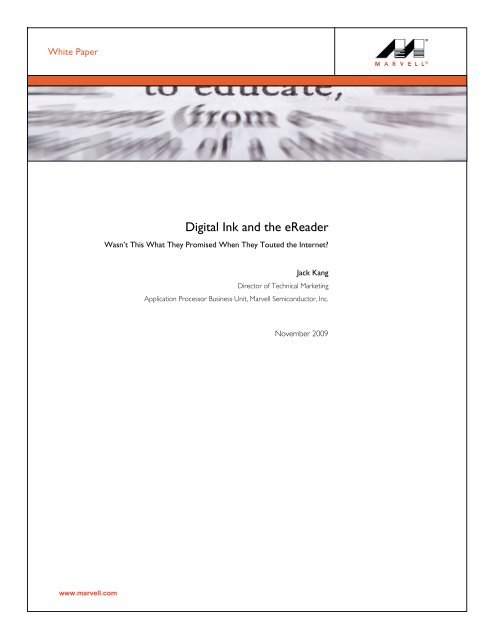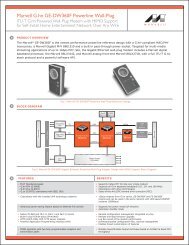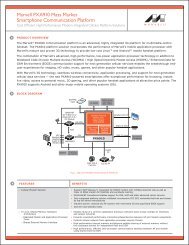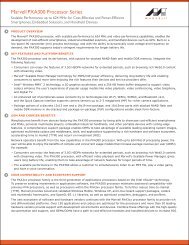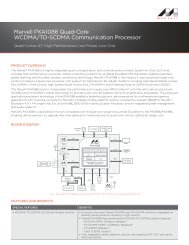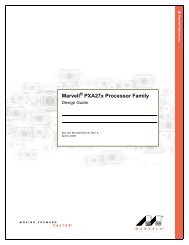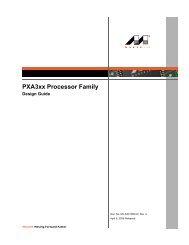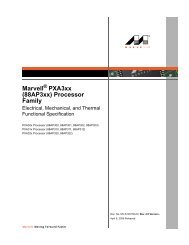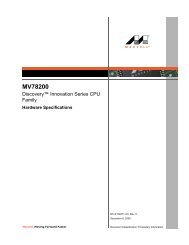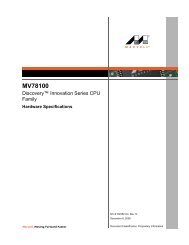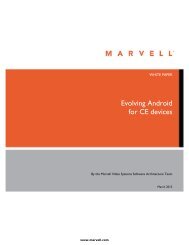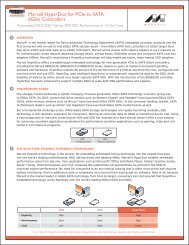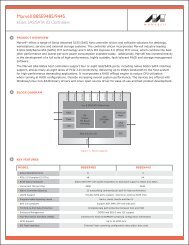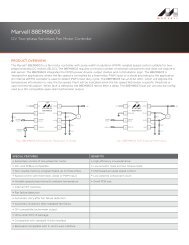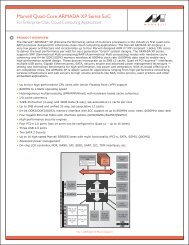Digital Ink and the eReader - Marvell
Digital Ink and the eReader - Marvell
Digital Ink and the eReader - Marvell
You also want an ePaper? Increase the reach of your titles
YUMPU automatically turns print PDFs into web optimized ePapers that Google loves.
White Paper<br />
www.marvell.com<br />
<strong>Digital</strong> <strong>Ink</strong> <strong>and</strong> <strong>the</strong> <strong>eReader</strong><br />
Wasn’t This What They Promised When They Touted <strong>the</strong> Internet?<br />
Jack Kang<br />
Director of Technical Marketing<br />
Application Processor Business Unit, <strong>Marvell</strong> Semiconductor, Inc.<br />
November 2009
Introduction<br />
When people first started talking about <strong>the</strong> promises of <strong>the</strong> Internet, did <strong>the</strong>y not say <strong>the</strong>y would no longer have to print<br />
newspapers? You could get your news in real time, from anywhere around <strong>the</strong> world. Textbooks would never become obsolete <strong>and</strong><br />
could enthrall students with multimedia content, photos, videos <strong>and</strong> links to related websites.<br />
That didn’t happen, did it? Although we are now seeing trends toward online news, one limiting factor to pervasive online book<br />
publishing has been readability. Until digital ink <strong>and</strong> small-form factor portable <strong>eReader</strong>s, <strong>the</strong>re hasn’t been a major rush to move<br />
publishing to strictly online formats. But with <strong>the</strong> advent of better mobile <strong>and</strong> digital ink technologies, that Internet promise could be<br />
here soon.<br />
What Is <strong>Digital</strong> <strong>Ink</strong> And How Is An <strong>eReader</strong> Different?<br />
Despite <strong>the</strong> advances in display technology, as <strong>the</strong> computer <strong>and</strong> consumer electronics worlds go digital, human beings still have a<br />
human body that responds to analog—from <strong>the</strong> sound waves we hear to <strong>the</strong> color <strong>and</strong> lights we see. So despite CRT, TFT, LCD,<br />
plasma, or o<strong>the</strong>r display technologies, humans still find it easier to read off of paper.<br />
That is why e-paper, digital ink <strong>and</strong> <strong>eReader</strong>s were created--to reduce <strong>the</strong> eye strain inherent in back-lit or o<strong>the</strong>r display<br />
technologies. In fact, digital paper works nearly opposite <strong>the</strong> st<strong>and</strong>ard computer screen display. First, it looks more like paper <strong>and</strong><br />
uses actual pigments. It is not backlit or refreshed. You can read an <strong>eReader</strong> outdoors or in direct sunlight, unlike a backlit display,<br />
which loses all of its readability in direct sunlight.<br />
The digital ink technology was created by a Massachusetts company named E <strong>Ink</strong> based on research started at <strong>the</strong> MIT Media Lab.<br />
E <strong>Ink</strong> Corporation is <strong>the</strong> leading supplier of electronic paper display (EPD) technologies, a high contrast display that gives a paperlike<br />
appearance. EPDs can be used in a variety of consumer <strong>and</strong> industrial applications, from h<strong>and</strong>held devices to watches, clocks,<br />
public information or promotional signs. E <strong>Ink</strong> is currently mass manufactured in <strong>the</strong> more widely known Amazon Kindle <strong>and</strong> Sony<br />
Reader.<br />
The principal components of electronic ink are millions of tiny microcapsules, instead of individual pixels as used in traditional LCD<br />
technology. Each microcapsule contains positively charged white particles <strong>and</strong> negatively charged black particles suspended in a<br />
viscous fluid. E <strong>Ink</strong> builds a thin piece of film with <strong>the</strong> microcapsules. The film is <strong>the</strong>n glued on top of a Thin-Film-Transitor (TFT.)<br />
The TFT electrically charges <strong>the</strong> pigments causing <strong>the</strong> white or black dots of pigment to rise through <strong>the</strong> fluid to <strong>the</strong> surface to create<br />
<strong>the</strong> black-<strong>and</strong>-white images. (Currently <strong>eReader</strong>s are produced only in black-<strong>and</strong>-white, but companies are already working on <strong>the</strong><br />
use of color in EPDs.)<br />
E-ink does not need to be refreshed like backlit technology. The image stays in place until <strong>the</strong> next electrical charge (for example,<br />
when <strong>the</strong> reader turns a page.) So an <strong>eReader</strong> display can power down to zero, using less power overall than a display that<br />
constantly needs refreshing.<br />
Technologies Empowering <strong>eReader</strong>s<br />
Easier to read screens <strong>and</strong> lower power consumption are functions that are driving <strong>the</strong> acceptance of <strong>eReader</strong> technology. O<strong>the</strong>r<br />
technologies <strong>and</strong> market dynamics are also converging to help empower <strong>eReader</strong> adoption. For example, <strong>the</strong> proliferation of ultramobile<br />
h<strong>and</strong>held devices, Wi-Fi, Bluetooth, 3G modems <strong>and</strong> power management, make Internet accessibility portable <strong>and</strong> ubiquitous.<br />
Display <strong>and</strong> silicon manufacturers are creating new solutions for <strong>the</strong> next generation. Let’s see how it works.<br />
Technology Background—Frontplane—Backplane<br />
While E <strong>Ink</strong> was one of <strong>the</strong> first to commercialize e-paper, o<strong>the</strong>r companies like Sipix, are now jumping into <strong>the</strong> game. While epaper<br />
technology is currently only in black-<strong>and</strong>-white, color is already being researched as well as animation. Some will take <strong>the</strong> epaper<br />
technology <strong>and</strong> use it on plastic or create screens that will roll up (putting a fresh spin on e-scrolls to be sure!) But all this<br />
technology is referring to <strong>the</strong> frontplane.<br />
The frontplane is <strong>the</strong> actual material, or film, that is used to hold <strong>the</strong> pigment <strong>and</strong> typically consists of tiny capsules or physical<br />
particles that move to electric charge.<br />
Next page shows how E <strong>Ink</strong> <strong>and</strong> Sipix implement <strong>the</strong>ir frontplane technology.<br />
Page 2 <strong>Digital</strong> <strong>Ink</strong> <strong>and</strong> <strong>the</strong> <strong>eReader</strong> November 2009
Figure 1: (Lt. to Rt.) E <strong>Ink</strong> Frontplane Microcapsules, Sipix Frontplane Microcups, Final Thin Film Product.<br />
The final frontplane product is a thin film that is flexible <strong>and</strong> can be cut into any size. The frontplane needs to be placed on top of<br />
something that can drive <strong>the</strong> bottom electrode, charging <strong>the</strong> particles <strong>and</strong> creating <strong>the</strong> color gradations <strong>and</strong> changes.<br />
Welcome to <strong>the</strong> Backplane<br />
The backplane is typically a TFT display or o<strong>the</strong>r device that actually drives <strong>the</strong> panel. The frontplane is attached to <strong>the</strong> backplane.<br />
Currently, backplane sizes limit <strong>the</strong> e-paper sizes being offered as e-paper companies try to follow <strong>the</strong> same size as LCD<br />
manufacturers to take advantage of those TFT display backplanes made for current devices.<br />
Backplane players include TFT-LCD manufacturers, such as Taiwan-based Prime View International (who at <strong>the</strong> time of writing this<br />
paper are in <strong>the</strong> process of acquiring E <strong>Ink</strong>); LG Displays who currently partners with E <strong>Ink</strong> <strong>and</strong> is a main supplier along with PVI;<br />
Plastic Logic (PL) which differentiates its backplane from TFT by making its backplane from plastic; AU Optronics (AUO), one of <strong>the</strong><br />
world’s largest TFT-LCD panel manufacturers, who is acquiring a major stake in Sipix.<br />
Driving <strong>the</strong> Frontplane <strong>and</strong> Backplane Technologies<br />
Then, <strong>the</strong>re are <strong>the</strong> supporting platform technologies that drive <strong>the</strong> frontplane <strong>and</strong> <strong>the</strong> backplane technologies. For example, you<br />
need a controller. Unlike LCDs, <strong>the</strong>re are no st<strong>and</strong>ard EPD controllers. Current device makers ei<strong>the</strong>r use a dedicated chip that works<br />
with EPD displays or an FPGA. In addition to <strong>the</strong> controller o<strong>the</strong>r processors <strong>and</strong> discrete parts are needed, such as DRAM <strong>and</strong> flash<br />
memory.<br />
Figure 2: E-Paper Display Architecture: O<strong>the</strong>rs vs. <strong>Marvell</strong>.<br />
<strong>Marvell</strong> has designed a new <strong>eReader</strong> hardware platform solution to help original equipment manufacturers (OEMs) rapidly release<br />
next-generation <strong>eReader</strong>s. <strong>Marvell</strong> has introduced its <strong>Marvell</strong> ARMADA 166E application processor, which integrates a highperformance<br />
<strong>eReader</strong> processor <strong>and</strong> state-of-<strong>the</strong>-art EPD controller on a single chip. The ARMADA 166E with <strong>the</strong> integrated EPD<br />
controller is designed to offer OEMs ultra fast renderings of high-resolution PDF documents <strong>and</strong> support for <strong>the</strong> latest e-paper<br />
technologies, plus extended battery life in new smaller, slimmer form factors.<br />
<strong>Marvell</strong>’s solution makes <strong>the</strong> hardware design easier creating a total platform solution, which also includes <strong>Marvell</strong> key technologies<br />
such as Wi-Fi, Bluetooth, 3G modem, video <strong>and</strong> power management. The company also offers OEMs a developer’s kit <strong>and</strong> turnkey<br />
reference design for a highly integrated, low-cost solution. This way, OEMs can focus on custom <strong>and</strong> unique applications, which <strong>the</strong>y<br />
can get to market more quickly. <strong>Marvell</strong>’s platform reduces <strong>the</strong> number of discreet components <strong>and</strong> <strong>the</strong>refore, <strong>the</strong> cost. In addition,<br />
it supports Window CE, Google Android <strong>and</strong> Linux operating systems.<br />
Next page shows <strong>the</strong> <strong>Marvell</strong> ARMADA 166E with integrated EPD.<br />
November 2009 <strong>Digital</strong> <strong>Ink</strong> <strong>and</strong> <strong>the</strong> <strong>eReader</strong> Page 3
Figure 3: <strong>Marvell</strong> ARMADA 166E with Integrated EPD.<br />
Highlights of <strong>the</strong> EPD controller from <strong>Marvell</strong> include:<br />
• UXGA (1200x1600 resolution)<br />
• Partial <strong>and</strong> parallel display update for better performance<br />
• Pixel depth 1, 3 or 4 bit per pixel<br />
• Optional interface to external secure IC<br />
Included in <strong>the</strong> board design is <strong>the</strong> <strong>Marvell</strong> ARMADA 166E with 800 MHz CPU <strong>and</strong> Sheeva PJ1 CPU core <strong>and</strong> WMMX2 Multimedia<br />
coprocessor. The ARMADA 166E includes ARMv5/XScale technology capabilities, with built-in 32Kb L1 cache <strong>and</strong> 128KB L2 cache.<br />
See specs for memory, LCD controller, graphics, video, peripherals <strong>and</strong> process/package specifics at<br />
http://www.marvell.com/products/armada.<br />
In addition to its processing core, is <strong>Marvell</strong>’s patented Qdeo video processing technology, plus memory, DDR1/2 SDRAM controller,<br />
graphics acceleration overlays, color conversion, HQ scaler, EPD display interface, connectivity <strong>and</strong> all else needed for a flexible <strong>and</strong><br />
robust <strong>eReader</strong> package. More integration means lower cost <strong>and</strong> ease of hardware design.<br />
Markets <strong>and</strong> Applications:<br />
As <strong>the</strong> technology develops, <strong>the</strong> <strong>eReader</strong> industry l<strong>and</strong>scape begins to unfold. The diagram below shows <strong>the</strong> ecosystem developing<br />
to support <strong>the</strong> <strong>eReader</strong> industry including: <strong>eReader</strong> OEMs already in <strong>the</strong> market, <strong>the</strong> e-paper display OEMs that manufacture <strong>the</strong><br />
frontplane, e-paper ODMs, content aggregators <strong>and</strong> distributors that will sell <strong>the</strong> books <strong>and</strong> content owners that will publish. O<strong>the</strong>r<br />
players that will influence <strong>and</strong> grow <strong>the</strong> market include <strong>the</strong> government (by developing or m<strong>and</strong>ating things like e-textbooks),<br />
wireless carriers, device manufacturers <strong>and</strong> software companies. Globally, as countries begin to manage <strong>the</strong>ir limited resources <strong>and</strong><br />
embark on green lower-energy initiatives, <strong>eReader</strong>s may come to <strong>the</strong> forefront to help reduce paper <strong>and</strong> waste.<br />
Figure 4: <strong>eReader</strong> Industry L<strong>and</strong>scape<br />
e-Book OEMs e-Paper ODMs<br />
• Amazon<br />
• Sony<br />
• Plastic Logic<br />
• Hanwang<br />
• Jinke (Hanling)<br />
• First Paper<br />
• Entourage<br />
• Asus<br />
• 15+ o<strong>the</strong>r<br />
• Ensky<br />
• Foxconn<br />
• IAC<br />
• etc.<br />
e-Paper Display<br />
OEMs<br />
• E <strong>Ink</strong> - PVI<br />
• Sipix - AUO<br />
• O<strong>the</strong>r startups<br />
O<strong>the</strong>r Players<br />
• Government<br />
(e-textbooks)<br />
• Wireless carriers<br />
• Google, Adobe<br />
Content Aggregator<br />
& Distributor<br />
• Amazon<br />
• Barnes & Noble<br />
• First Paper<br />
• O<strong>the</strong>rs<br />
Content Owners<br />
• Book publishers<br />
• Newspapers -NYT,<br />
WSJ, etc<br />
• Magazines – Time,<br />
Fortune, etc<br />
• Textbook publishers<br />
• Business documents<br />
Page 4 <strong>Digital</strong> <strong>Ink</strong> <strong>and</strong> <strong>the</strong> <strong>eReader</strong> November 2009
Since <strong>eReader</strong>s are easy to use <strong>and</strong> easier on <strong>the</strong> eyes <strong>and</strong> now combine a number of technologies, <strong>the</strong>y offer several advantages for<br />
consumers including:<br />
Easier Access: <strong>eReader</strong> formats, including <strong>eReader</strong>s, e-newspapers, e-magazines, e-textbooks, e-learning <strong>and</strong> e-documents, will<br />
save time, because content will be available via Wi-Fi <strong>and</strong> 3G. Services are being created that will automatically update newspapers,<br />
magazines, comics, book lists, even text books on a monthly, hourly or real-time basis. You would be able to pick up <strong>the</strong> Wall Street<br />
Journal, New York Times, your favorite local or international paper anytime <strong>and</strong> newspaper publishing houses will not have to worry<br />
about driving to <strong>the</strong> 5:00 p.m. deadline for news.<br />
Easier on <strong>the</strong> environment: There will be less need to print or waste paper with <strong>eReader</strong>s. In a way, e-paper continually recycles. In<br />
addition, because it does not need to be refreshed, as soon as <strong>the</strong> reader turns <strong>the</strong> page, <strong>the</strong> power can be turned off. That means<br />
<strong>the</strong>re is less battery drain <strong>and</strong> less need for electrical recharges.<br />
Easier on <strong>the</strong> back: <strong>eReader</strong>s will save space. No longer will book bags be needed for students to carry multiple textbooks. Business<br />
users won’t have to carry multiple books, newspapers, magazines or documents; <strong>the</strong>y can download all <strong>the</strong>ir content into one easyto-carry<br />
device.<br />
Easier on <strong>the</strong> billfold: Electronic books are cheaper to publish than printed versions. This will also lower <strong>the</strong> barriers to entry for new<br />
authors wanting to be published.<br />
Easy on <strong>the</strong> eyes: As already mentioned, <strong>the</strong> screen technology is nearly as easy to read as paper, however, <strong>the</strong>re are o<strong>the</strong>r<br />
advantages. Fonts can be increased or decreased. Before, only certain books, newspapers or magazines were available in large<br />
print—now you can change <strong>the</strong> font, increase its size or zoom images, for your personal reading comfort.<br />
As new players enter <strong>the</strong> market, new technologies <strong>and</strong> techniques are being developed that will help drive <strong>the</strong> market <strong>and</strong> create<br />
new applications for electronic paper-based products. In fact, new processes are being developed for color e-ink, plastic screens <strong>and</strong><br />
disposable displays. According to <strong>the</strong> CLSA Asia Pacific Market, Aug. 26, 2009 E-Paper Primer Sector Outlook, here are some current<br />
<strong>and</strong> future applications for e-paper <strong>and</strong> <strong>eReader</strong> technology:<br />
Figure 5: Existing uses for e-paper<br />
Source: CLSA Asia-Pacific Markets<br />
CLSA expects applications like <strong>the</strong>se to drive a projected $2.8 billion dollar e-paper industry by 2015 that will include such creative<br />
uses as consumer electronics, disposable electronics, electronic signage (POP/ESL), disposable signage <strong>and</strong> apparel.<br />
November 2009 <strong>Digital</strong> <strong>Ink</strong> <strong>and</strong> <strong>the</strong> <strong>eReader</strong> Page 5
According to a May 27, 2009 Forrester E-Reading Report, new features like bigger <strong>and</strong> more flexible displays, animation, enhanced<br />
sharing, color <strong>and</strong> video, will hit <strong>the</strong> market between 2010 <strong>and</strong> 2012. This will also help spur consumer interest in <strong>eReader</strong><br />
applications. Forrester sees <strong>the</strong> market changing from mainstream frequent book buyers in 2009 to 2011, to more mainstream<br />
business, student consumers from 2011 <strong>and</strong> beyond, when prices begin to drive down to <strong>the</strong> $99 sweet spot.<br />
Conclusion<br />
As <strong>the</strong> technologies come toge<strong>the</strong>r from frontplane <strong>and</strong> backplane companies <strong>and</strong> semiconductor leaders like <strong>Marvell</strong>, <strong>the</strong> breadth of<br />
opportunities for <strong>eReader</strong>s is beginning to reach critical mass <strong>and</strong> prices will start to come down. <strong>Marvell</strong>’s ARMADA 166E SoC,<br />
development kit <strong>and</strong> turnkey reference designs make it easier for manufacturers to come to market with highly integrated, lowercost<br />
solutions so consumers can start taking advantage of <strong>the</strong> readability <strong>and</strong> portability of <strong>eReader</strong>s.<br />
<strong>Marvell</strong>’s ARMADA <strong>eReader</strong> platforms enable large or small manufacturers to quickly develop <strong>eReader</strong> systems for a wide variety of<br />
end markets, from basic book readers to subscription content devices to dedicated enterprise <strong>and</strong> educational devices. EPD panels of<br />
multiple sizes are supported <strong>and</strong> <strong>the</strong> ARMADA platform also supports LCD screens, allowing for flexible implementation. With<br />
<strong>Marvell</strong>’s proven Wi-Fi/Bluetooth SoCs <strong>and</strong> HSDPA modem technology, connectivity to <strong>the</strong> WLAN or WWAN is a snap. Power<br />
management solutions from <strong>Marvell</strong> provide efficient switching regulators <strong>and</strong> power-factor correction for AC-DC adapters. <strong>Marvell</strong><br />
also offers full development systems <strong>and</strong> turnkey reference designs, as well as Linux, Android <strong>and</strong> Windows Embedded CE board<br />
support packages (BSPs) for <strong>eReader</strong>s.<br />
It’s products <strong>and</strong> services like <strong>the</strong>se from <strong>Marvell</strong> that will help make good on <strong>the</strong> early Internet promises of instant information at<br />
your fingertips.<br />
Footnotes:<br />
1. CLSA Asia-Pacific Markets, “EPaper Primer”, by Oliver Campbell, August 26, 2009.<br />
2. Forrester Research, “How Big is <strong>the</strong> <strong>eReader</strong> Opportunity?” by Sarah Rotman Epps for Consumer Product Strategy Professionals, May 27, 2009.<br />
Jack Kang<br />
Director of Technical Marketing,<br />
Application Processor Business Unit, <strong>Marvell</strong> Semiconductor, Inc.<br />
Jack Kang is currently Director of Technical Marketing for <strong>Marvell</strong>'s Application Processor Business Unit. He is responsible for multiple<br />
consumer market segments, including <strong>eReader</strong>s, gaming, <strong>and</strong> o<strong>the</strong>r connected consumer gadgets, <strong>and</strong> also serves as a technical<br />
expert on CPU technology. Prior to this role, Jack worked as a logic design engineer in <strong>Marvell</strong>'s CPU design team. He has more than<br />
10 patents pending in <strong>the</strong> field of CPU technology, <strong>and</strong> holds a degree in Electrical Engineering <strong>and</strong> Computer Science from <strong>the</strong><br />
University of California, Berkeley, with an emphasis in Computer Architecture.<br />
Page 6 <strong>Digital</strong> <strong>Ink</strong> <strong>and</strong> <strong>the</strong> <strong>eReader</strong> November 2009
<strong>Marvell</strong> Semiconductor, Inc.<br />
5488 <strong>Marvell</strong> Lane<br />
Santa Clara, CA 95054, USA<br />
Tel: 1.408.222.2500<br />
www.marvell.com<br />
Copyright © 2009. <strong>Marvell</strong> International Ltd. All rights reserved.<br />
<strong>Marvell</strong>, Moving Forward Faster, <strong>and</strong> <strong>the</strong> <strong>Marvell</strong> logo are registered<br />
trademarks of <strong>Marvell</strong> or its affiliates. Armada, Sheeva, <strong>and</strong> Qdeo are<br />
trademarks of <strong>Marvell</strong> or its affiliates. O<strong>the</strong>r names <strong>and</strong> br<strong>and</strong>s may<br />
be claimed as <strong>the</strong> property of o<strong>the</strong>rs.<br />
<strong>eReader</strong>_whitepaper-001 11/2009


